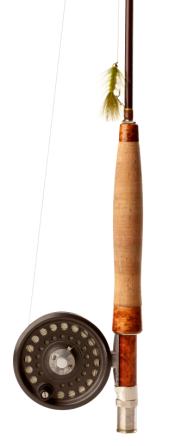Fly Fishing Rods vary greatly and normally comes packaged in sections from 2 up to 6 pieces. This makes it easier for the fisherman to store before and after his fishing trip. Each rod is designed to accept a fly line of a particular weight known as it's AFTM rating.
Fly Rods get picked and bought for the specific condition or situation, action of the rod and type of fish which the fisherman intends to fish for. The easiest way to obtain right fly fishing outfit is to buy a beginner fly fishing combo that includes the rod, reel and matching fly line.
Here are how to select the Fly Fishing rod suitable for your circumstances. You need to get the correct gear right from the start in order to
Preference for a rod depends entirely on the following:
- The fisherman's style of casting.
- Rod action - fast, medium(intermediate) and slow action.
- Weather conditions - if it's a windy day a rod with a stiff action is preferred.
- Location - stream, river, dam, lake or saltwater - short or long rod.
- Type of fish - trout, pike, barbell, sailfish etc.
Looking at the Fly Fishing Rods available today.
You have got a choice between Graphite, Glass fiber, Bamboo(Split cane) and Boron in different lengths ranging from 6 feet to 9 feet or more. Your Fly rod of choice depends on the location, conditions and the type of fish you want to catch.
Most rods these days are made of graphite (which tends to be lighter and more specialized) then there are fiberglass (very cheap rods) or even bamboo rods(which may be a little heavier and very expensive - more for the connoisseur fisherman, these rods do give a more precise presentation over short distances)
Buying a Fly Rod
When you decided on the length of the rod you want you've got to consider the following if you want a good rod:
- The material used in the manufacturing of the rod.
- The action of the rod.
- The finish on the rod.
- The fittings, dampening and the price you can afford.
Fly Fishing Rod Parts
The fly rod transfers energy from the fly fisher to the line, leader and then the fly. Rod length, taper and action are specifically designed for this specific purpose.The fly rod must be balanced with the correct fly-line weight for optimum performance in fly casting and the presentation or landing of the fly on the water in the target area. Most modern fly rods have the correct line-balance information printed on them just forward of the handle and hookkeeper.
There are six parts that make up the modern fly rod:
- Handle - The handle( cork grip) includes the butt cap, the reel-lock seat for attaching and securing the fly reel in place, and the handle check cap.
- Butt - The butt section, the first part of the rod, includes the area from the handle to the first ferrule.
- Ferrule - The ferrule is the connection between sections of a fly rod. Ferrules are installed so a rod can be disassembled in smaller pieces and conveniently be carried and stored.
- Tip - This is the section from the last ferrule to the tip of the rod, or the smallest guide on the end of the rod.
- Hookkeeper - The hookkeeper is a little ring that holds the fly' s hook safely in place when the outfit is rigged but the fly fisher is not fishing.
- Guides - The Fly line feeds through these guides and control the line on the rod during casting. These guides includes the stripper guide, which is the first guide up the rod from the rod handle. These guides (also called snake guides) hold the fly line close to the rod during casting.
Rod Action
Fly-rod performance, especially during casting but also whilst fishing and fighting the fish, is termed as the action of the rod. Action is influenced by the rod's material, taper design, length and other fittings such as the ferrules and guides.There are 3 main categories of fly-rod actions:
 |
| 3 Different Fly Rod Actions |
- Slow Action - The rod feels heavy and unflexes in a slow, willowy manner after loading.
- Intermediate (Medium) Action - The rod is slightly heavy when flexed and unflexes smoothly when loaded.
- A medium-action, progressively loading fly rod is the best rod with which to learn the sport. Medium action is the best rod for beginners and are the most adaptable to a angler's individual timing and reflexes.
The beginner's rod should be 8 to 8 1/2 feet long, and it should be designed to cast a 6- or 7-weight line. This combination is light, it provides enough power to cast 20 to 60 feet, and it can control most of the flies used to fish for trout and bass and other inland fish.
Fast Action - The rod feels very stiff when flexed and unflexes rapidly when loaded or flexed by the line in casting. This is normally the rod of choice for experienced casters.



